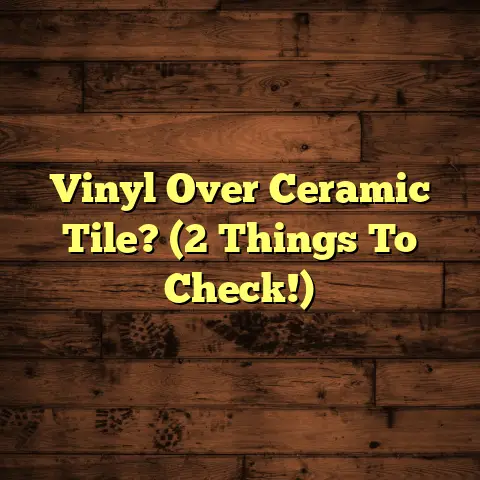Rejuvenate Wood Floors: Pro Secrets Here! (4 Steps Now!)
Wood floors are a classic for a reason. They add warmth, character, and value to any home. But let’s face it, life happens. Scratches, dents, and dullness can creep in over time.
Don’t worry, though! With the right knowledge and a little elbow grease, you can restore your wood floors to their former glory.
We’ll also bust some myths about wood floor durability along the way. So, grab a coffee, and let’s dive in!
Durability Myths of Wood Flooring
One of the biggest hurdles I face when talking to clients is overcoming misconceptions about how tough wood floors really are.
Let’s tackle these myths head-on, armed with facts and experience.
Myth #1: Wood Floors Are Too Delicate for High Traffic Areas
This is a big one! Many people think wood floors are only suitable for formal living rooms or bedrooms.
The truth is, with the right wood species and finish, wood floors can absolutely handle high-traffic areas like hallways, kitchens, and even entryways.
Think about engineered hardwood. It’s constructed with multiple layers, making it more stable and less prone to warping than solid hardwood.
I often recommend it for areas with higher moisture levels, too.
Plus, today’s polyurethane finishes are incredibly durable. They provide a tough, protective layer that can withstand daily wear and tear.
According to the National Wood Flooring Association (NWFA), proper installation and finishing are key to ensuring wood floor longevity in any area of your home.
Myth #2: All Wood Floors Scratch Easily
Okay, let’s be real: all floors scratch to some extent.
But the idea that wood floors are inherently prone to scratching is misleading.
The key here is understanding the Janka hardness scale. This scale measures the relative hardness of different wood species.
For example, Brazilian Walnut (Ipe) has a Janka rating of over 3600, making it incredibly resistant to dents and scratches.
On the other hand, softer woods like Pine have a lower rating (around 870).
So, choosing a harder wood species is the first step.
Also, proper care makes a huge difference. Using rugs in high-traffic areas, placing felt pads under furniture legs, and avoiding abrasive cleaners can all help minimize scratching.
I tell my clients to think of their wood floors like a good leather jacket. It needs some love and care to stay looking its best.
Myth #3: Wood Floors Can’t Be Refinished Multiple Times
This myth stems from the fact that solid hardwood floors have a limited thickness of the wear layer (the wood above the tongue and groove).
Each time you refinish a solid wood floor, you sand down a portion of this wear layer.
However, most solid hardwood floors can be refinished multiple times – typically 4-6 times – over their lifespan.
Engineered hardwood, on the other hand, often has a thinner wear layer.
Some engineered floors can’t be refinished at all, while others can be refinished once or twice, depending on the thickness of the veneer.
Before buying, always check the manufacturer’s specifications to understand the refinishing potential.
I’ve seen floors that have been beautifully refinished after decades of use, bringing them back to their original glory.
Myth #4: Any Moisture Will Ruin Wood Floors
While it’s true that excessive moisture can damage wood floors, the idea that any moisture is a death sentence is simply not true.
Modern wood floor finishes and installation techniques have come a long way in mitigating moisture-related problems.
Water-resistant finishes, like those containing aluminum oxide, offer enhanced protection against spills and splashes.
Proper subfloor preparation and the use of moisture barriers during installation are also crucial.
I always advise my clients to clean up spills promptly and avoid excessive moisture when cleaning.
A slightly damp mop is fine, but never leave standing water on your wood floors.
Myth #5: Once Damaged, Wood Floors Are Beyond Repair
Not at all! Wood floors are surprisingly resilient, and many types of damage can be effectively repaired.
Scratches can often be buffed out or touched up with a stain pen. Dents can sometimes be steamed out.
Even more significant damage, like water stains or gouges, can often be repaired by a skilled flooring contractor.
I’ve successfully repaired floors with pet stains, furniture gouges, and even minor water damage.
The key is to address the damage promptly and to use the appropriate repair techniques.
Sometimes, a full refinishing is the best option, but often, spot repairs can be a cost-effective solution.
Step 1: Assessing Your Wood Floors
Before you even think about rejuvenation, you need to understand the current state of your floors.
This is like a doctor diagnosing a patient – you need to know what’s wrong before you can prescribe a treatment.
Here’s how I approach assessing a client’s wood floors.
Look for the Signs of Wear and Damage:
- Scratches: Are they superficial surface scratches, or deeper gouges?
- Dents: Are there many small dents, or a few large ones?
- Discoloration: Are there areas that are faded, stained, or have a different color than the rest of the floor?
- Cupping or Crowning: Are the edges of the boards higher or lower than the center? This indicates moisture issues.
- Gaps: Are there excessive gaps between the boards? This can also be a sign of moisture problems.
- Finish Condition: Is the finish dull, worn through in places, or peeling?
Understand Your Wood and Finish:
- Type of Wood: Is it solid hardwood or engineered hardwood? What species of wood is it (oak, maple, pine, etc.)?
- Type of Finish: Is it a surface finish (polyurethane, varnish) or a penetrating oil finish?
- History: Do you know when the floors were installed or last refinished?
If you are unsure about the type of wood species, you can try using these methods How to Identify the Species of Wood Flooring
Document the Current Condition:
- Take Photos: Take clear, well-lit photos of the entire floor, paying close attention to areas with damage.
- Make Notes: Write down your observations about the condition of the floor, including the type and extent of any damage.
- Keep Records: If you have any records about the floor’s installation or previous refinishing, keep them in a safe place.
This documentation will be invaluable when you’re deciding on the right rejuvenation method and when you’re comparing quotes from different contractors.
Step 2: Cleaning and Preparing the Surface
Think of this step as prepping a canvas before painting. You need a clean, smooth surface to work with.
Gather Your Supplies:
- Broom or Vacuum: For removing loose dirt and debris.
- Wood Floor Cleaner: Choose a cleaner specifically designed for wood floors. Avoid harsh chemicals, abrasive cleaners, and anything that contains ammonia or bleach.
- Mop: A microfiber mop is ideal for cleaning wood floors.
- Buckets: One for clean water and one for the cleaning solution.
- Painter’s Tape: For protecting baseboards and other trim.
- Drop Cloths: For protecting furniture and other surfaces.
Remove Furniture and Protect the Area:
- Clear the Room: Remove all furniture, rugs, and other items from the room.
- Protect Baseboards: Apply painter’s tape to the baseboards to protect them from splashes and scuffs.
- Cover Other Surfaces: Use drop cloths to protect any furniture or other surfaces that you can’t remove from the room.
Cleaning Process:
- Sweep or Vacuum: Thoroughly sweep or vacuum the floor to remove all loose dirt, dust, and debris.
- Prepare Cleaning Solution: Mix the wood floor cleaner with water according to the manufacturer’s instructions.
- Mop the Floor: Dip the microfiber mop into the cleaning solution, wring it out thoroughly, and mop the floor in the direction of the wood grain.
- Rinse the Mop: Rinse the mop frequently in the clean water bucket to remove dirt and grime.
- Dry the Floor: If necessary, dry the floor with a clean, dry cloth.
Important Considerations:
- Avoid Over-Wetting: Never saturate the floor with water. Use a damp mop, not a soaking wet one.
- Test in an Inconspicuous Area: Before cleaning the entire floor, test the cleaning solution in an inconspicuous area to make sure it doesn’t damage the finish.
- Follow Manufacturer’s Instructions: Always follow the manufacturer’s instructions for the cleaning products you use.
Step 3: Choosing the Right Rejuvenation Method
Now comes the crucial decision. What’s the best way to bring your floors back to life?
Here’s a breakdown of the most common methods:
1. Polishing:
- What it is: Applying a polish to the floor to restore shine and protect the finish.
- Pros: Quick, easy, and relatively inexpensive.
- Cons: Doesn’t address scratches or other damage. Only provides a temporary fix.
- Best for: Floors with minor surface wear and a dull finish.
- My Recommendation: Polishing is a good option for floors that are in generally good condition but need a little pick-me-up.
2. Buffing (Screening and Recoating):
- What it is: Lightly abrading the existing finish to remove minor scratches and imperfections, then applying a new coat of finish.
- Pros: More effective than polishing at removing scratches and restoring the finish. Less expensive and less time-consuming than refinishing.
- Cons: Doesn’t address deep scratches or damage. May not be suitable for floors with multiple layers of finish.
- Best for: Floors with moderate surface wear, scratches, and a dull finish.
- My Recommendation: Buffing is a great option for floors that have some scratches and wear but don’t require a full refinishing.
3. Refinishing:
- What it is: Sanding down the existing finish to bare wood, then applying new stain and finish.
- Pros: Addresses deep scratches, damage, and discoloration. Allows you to change the color of the floor.
- Cons: More expensive and time-consuming than polishing or buffing. Requires specialized equipment and skills.
- Best for: Floors with significant damage, deep scratches, discoloration, or a finish that is peeling or worn through.
- My Recommendation: Refinishing is the most comprehensive rejuvenation method and is the best option for floors that are in poor condition.
DIY vs. Hiring Professionals:
- Polishing: This is a relatively easy DIY project that most homeowners can handle.
- Buffing: This requires some experience and specialized equipment, but it can be done as a DIY project if you’re comfortable with power tools.
- Refinishing: This is a complex and time-consuming project that is best left to professionals.
Here’s a quick guide to help you decide:
| Condition of Floors | Recommended Method | DIY or Professional? |
|---|---|---|
| Minor surface wear, dull finish | Polishing | DIY |
| Moderate surface wear, scratches, dull finish | Buffing | DIY (with experience) or Professional |
| Significant damage, deep scratches, discoloration, peeling finish | Refinishing | Professional |
Step 4: Maintaining Your Rejuvenated Wood Floors
Congratulations! You’ve successfully rejuvenated your wood floors.
But the job’s not done yet. Now, you need to protect your investment and keep your floors looking their best for years to come.
Here’s my comprehensive maintenance plan.
Regular Cleaning:
- Sweep or Vacuum Regularly: Sweep or vacuum your floors at least once a week to remove loose dirt, dust, and debris.
- Mop as Needed: Mop your floors as needed with a wood floor cleaner. Avoid over-wetting the floor and always follow the manufacturer’s instructions for the cleaning product.
- Use Doormats: Place doormats at all entrances to trap dirt and moisture before they reach your wood floors.
Protective Measures:
- Use Rugs: Place rugs in high-traffic areas to protect the finish from wear and tear.
- Use Felt Pads: Attach felt pads to the legs of all furniture to prevent scratches and dents.
- Avoid High Heels: Avoid wearing high heels on your wood floors, as they can cause dents and scratches.
Seasonal Care:
- Humidity Control: Maintain a consistent humidity level in your home to prevent wood floors from expanding and contracting.
- Temperature Settings: Avoid extreme temperature fluctuations, as they can also damage wood floors.
- Winter Care: During the winter months, when the air is dry, consider using a humidifier to add moisture to the air.
- Summer Care: During the summer months, when the air is humid, consider using a dehumidifier to remove excess moisture from the air.
Periodic Inspections and Touch-Ups:
- Inspect Regularly: Inspect your floors regularly for signs of wear, damage, or moisture problems.
- Touch-Up Scratches: Touch up scratches and other minor damage as soon as possible to prevent them from worsening.
- Recoat as Needed: If the finish on your floors starts to look dull or worn, consider recoating them with a new layer of finish.
By following these maintenance tips, you can keep your rejuvenated wood floors looking beautiful for years to come.
Conclusion
So, there you have it – my pro secrets for rejuvenating your wood floors!
We’ve covered everything from debunking common myths to assessing your floors, choosing the right rejuvenation method, and maintaining your beautiful wood floors.
Remember, wood floors are a valuable asset to your home. With a little care and attention, they can last for generations.
Don’t let the myths scare you away from enjoying the beauty and warmth of wood floors.
Take proactive steps to rejuvenate and maintain your floors, and you’ll be rewarded with a lifetime of beauty and value.
Now, go forth and rejuvenate those floors! You’ve got this!





